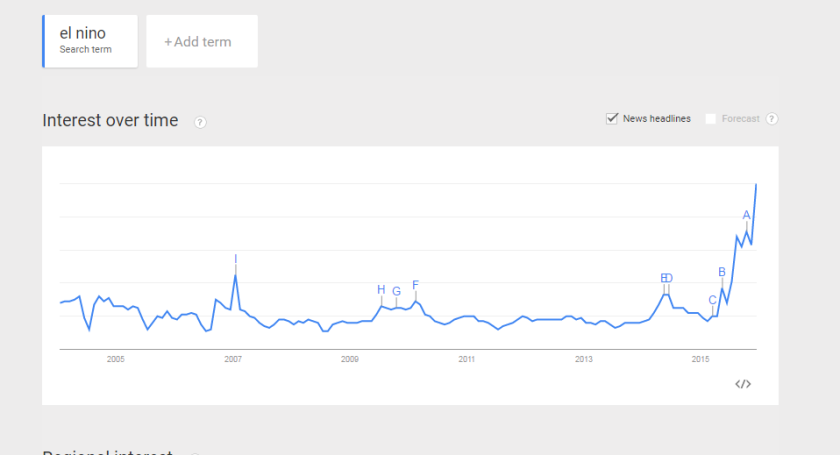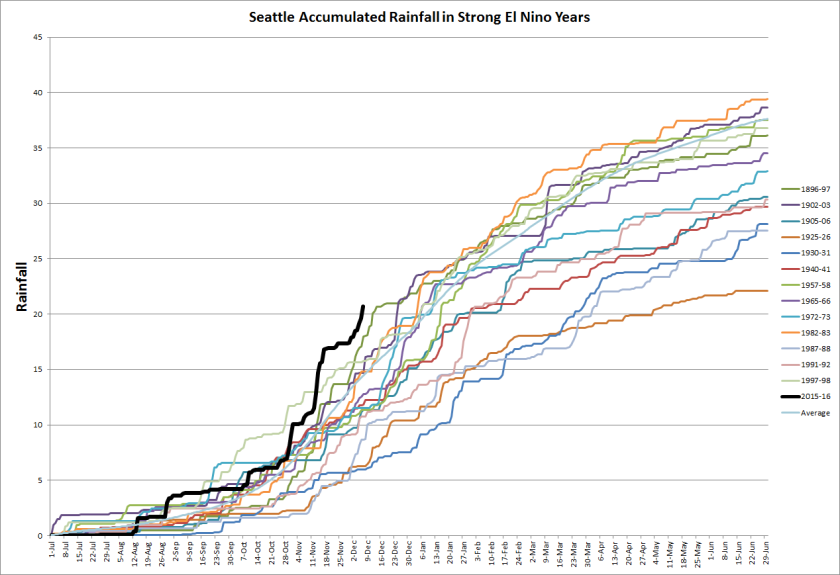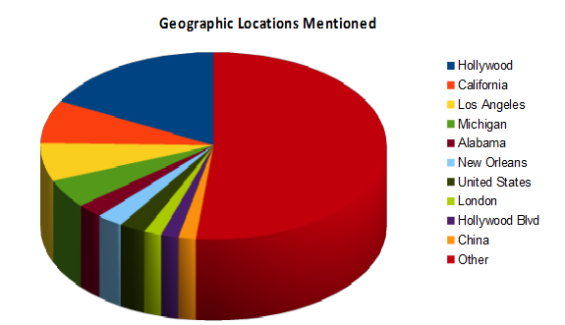The fever pitch of El Nino headlines and articles isn’t slowing down. In fact, it’s only growing:

It comes mostly with speculation, preparation, and wonder. Some of the headlines are ridiculous (just go back through photos on my Twitter timeline). Most are reasonable. But it’s news. And it’s clearly a high impact weather phenomenon.
So it begs the question: How’s it doing? Is El Nino behaving like it’s supposed to? Specifically with regard to rainfall. Remember, this El Nino event is a strong one. In fact, it’s the strongest since 1997, and in some respects, it may be the strongest on record. So we have a pretty clear set of analogs to look at and see if this year fits the mold.
Judging by the temperature forecast for the next 10-15 days, the pattern seems to be mostly behaving like a strong El Nino should in December. How about rain? Let’s look back at other actual strong El Nino events and see where 2015-16 is falling relative to those events, specifically in terms of rainfall.
A caveat here: Remember, it’s early. Winter is a marathon, not a sprint. Because something looks one way on December 8th, doesn’t mean one month from now we’re going to be in the same boat. But there are a few interesting nuggets to pull out of this, and I think it’s mostly a good idea to give people some perspective on certain story lines.
Just as a note, my definition for “strong” El Nino events was using a blend from Jan Null’s list post-1950 and Klaus Wolter’s list pre-1950, as well as some “artistic liberty.” Not everyone agrees on the perfect definition of what a strong El Nino is, but hopefully I captured the majority. I’m tracking rain from July 1-June 30.
Southern California
When people think of El Nino, many think of SoCal. You know, mudslides in Malibu, etc. I believe the mayhem of 1997-98 and subsequent personification by Chris Farley has set a level of expectations.
Thus far, 2015 is behaving pretty much about where other strong El Nino events have done in Los Angeles:

Every strong El Nino event back to the 1800s has had normal or above normal rainfall in Los Angeles. Thus far, thanks mostly to a freak wet event in early autumn, Los Angeles is indeed above normal. It is worth noting, that 2015-16 wouldn’t be the only strong El Nino year to see a “freak” early autumn rainfall event followed by a prolonged period of dryness into December. So if people are wondering where the rain is, wait a few more weeks. We are entering the ramp up period. If things don’t start picking up by late month, then we can start to worry.
Northern California
Northern California is a conundrum during strong El Nino events. Historically, San Francisco is split between above and below normal rainfall, so it’s tough to say too much at this early stage. That said, it is worth nothing, that as of right now, this El Nino is on the lower end of the envelope in terms of rainfall in strong El Nino events in the Bay Area:

Like Los Angeles, it’s still early. The ramp should start soon if we’re going to go above normal, so again, if things don’t perk up by late December, it might be time to plan on a normal or drier than normal winter at best.
Washington/Oregon
This is where it gets interesting. For the most part, the El Nino signal in the Pacific Northwest is somewhat mixed. You get dry years and you get wet years. Usually, however, you don’t have a super wet year when there’s a strong El Nino.
In Portland (where the data is only available back to the 1957-58 El Nino) no strong El Nino has been wetter than normal. Seattle is mixed from slightly above normal to way below normal. So far in Seattle? It’s the wettest strong El Nino to this point on record, and it’s not even close. This autumn has been incredibly wet so far.

If we keep up at this rate (and the current forecast implies this), this will quickly become one the wettest, if not the wettest strong El Nino event on record in Seattle.
Great Basin/Rockies
In Denver, the bend is toward a wetter than normal outcome in strong El Nino years, but it is mixed. So far, Denver has been mid-pack for strong El Nino events.

Salt Lake City is a bit more mixed, split almost evenly between wetter than normal and drier than normal (82-83 was a beast there). So far, we’re doing middle of the pack there also.

It will be interesting to follow this as we go through the cold season. I’ll likely be tracking this, as it’s good to establish where this El Nino event falls. For everyone, it will probably be different. But thankfully we have a useful sample in a number of places to utilize.






